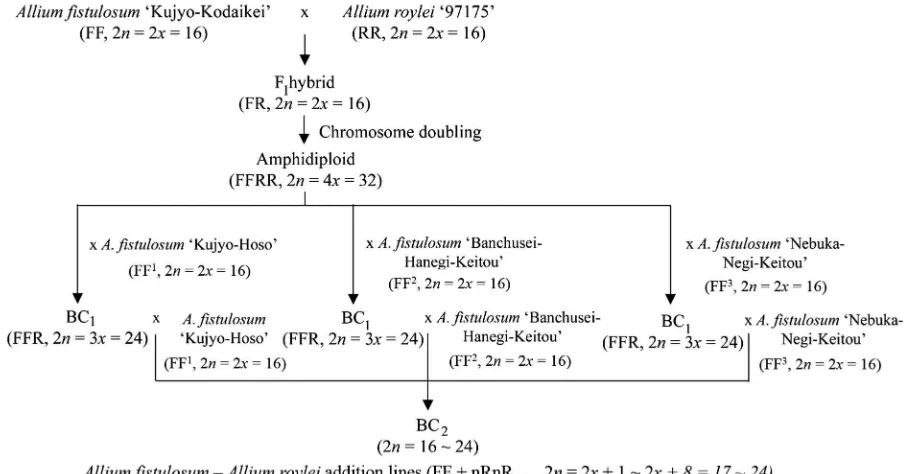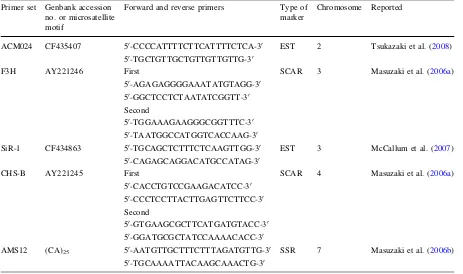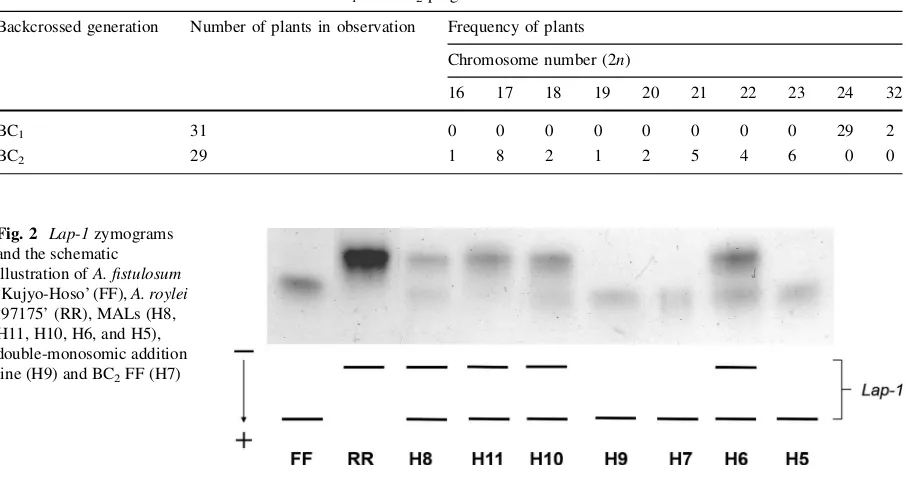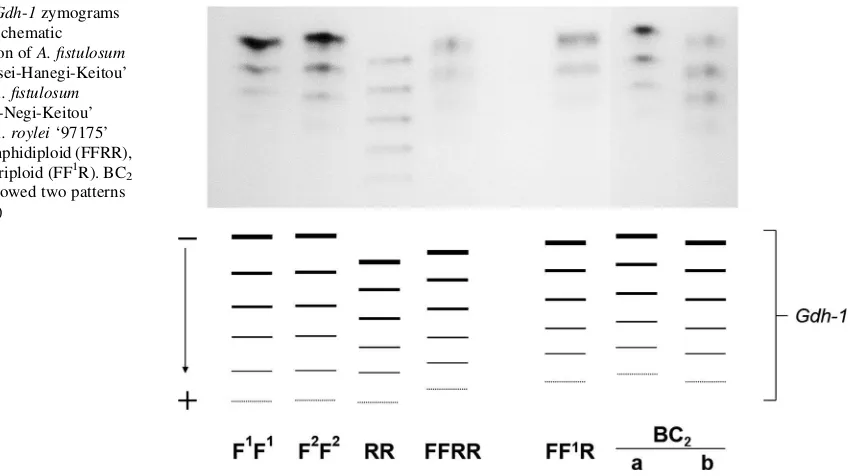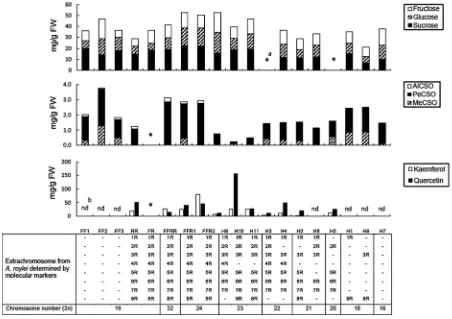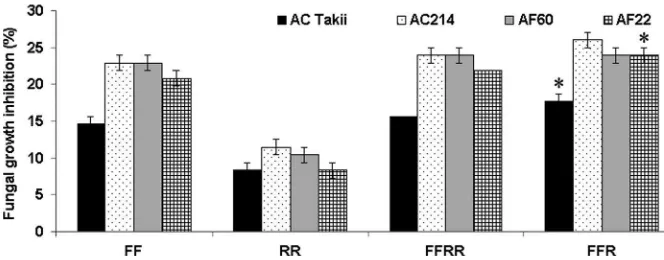Production and characterization of alien chromosome
addition lines in
Allium fistulosum
carrying extra
chromosomes of
Allium roylei
using molecular
and cytogenetic analyses
Nur Aeni Ariyanti.Vu Quynh Hoa.Ludmila I. Khrustaleva .Sho Hirata. Mostafa Abdelrahman.Shin-ichi Ito.Naoki Yamauchi.
Masayoshi Shigyo
Received: 6 November 2014 / Accepted: 19 May 2015 ÓSpringer Science+Business Media Dordrecht 2015
Abstract Allium roylei was employed for the pro-duction of alien chromosome addition lines in A. fistulosum.Interspecific hybridization betweenA. fistu-losumandA. royleisuccessfully produced F1hybrids.
Chromosome doubling of an F1hybrid was carried out
to produce amphidiploids. After two times backcrossing of the amphidiploids with A. fistulosum, a BC2
gen-eration was obtained with chromosome numbers (2n) ranging from 16 to 23. Alien monosomic addition lines (AMAL, FF?nR, 2n=17) appeared with the highest frequency. Furthermore, multiple addition lines (MAL, 2n =18–23) were also observed with lower frequen-cies. Five AMALs (FF?1R, ?3R, ?4R, ?5R, and
?8R) and ten MALs (2n=18–23) were characterized
using isozyme and DNA markers. The extra chromo-somes from A. roylei clearly altered the biochemical characteristics of the MALs. Variations in sugar, cysteine sulfoxide, and flavonoid contents were ob-served among the MALs in various amounts. Allium fistulosum–A. roylei allotriploids (2n=24, FFR) showed significantly higher saponin content and anti-fungal activities of saponin extracts against isolates of Fusarium oxysporumf. sp.cepaein comparison withA. fistulosum. This first report ofA. fistulosum–A. roylei addition lines opens the possibility of developing novel A. fistulosumcultivars with enhanced nutritional value and disease resistance.
Keywords Allium fistulosumAllium royleiAlien addition linesAntifungal activityBiochemical variation
Introduction
The Japanese bunching onion (JBO) (Allium fistulo-sumL., 2n =2x=16, genomes FF) is an important Alliumspecies in East Asia (Inden and Asahira1990). It has been cultivated by both open-pollinated and F1
hybrid seeds. In Japan, there are approximately 120 registered JBO cultivars with improved quality, heat tolerance, and bolting resistance (Inden and Asahira 1990). A. fistulosum has been reported as a good N. A. AriyantiS. HirataM. Abdelrahman
S. ItoN. YamauchiM. Shigyo
The United Graduate School of Agricultural Sciences, Tottori University, 4-101 Koyama-Minami,
Tottori 680-8553, Japan
V. Q. Hoa
Department of Vegetable Flower Fruit Crop Science, Faculty of Agronomy, Hanoi University of Agriculture, Gia Lam, Hanoi, Vietnam
L. I. Khrustaleva
Russian State Agrarian University, Moscow Timiryazev Agricultural Academy, Timiryazev Street 44, Moscow, Russia
S. ItoN. YamauchiM. Shigyo (&)
Faculty of Agriculture, Yamaguchi University, 1677-1 Yoshida, Yamaguchi 753-8515, Japan
source of disease resistance which may be of interest for breeding (Kik2002). However, it still suffers from some serious diseases, such as Fusarium wilt (Dis-sanayake et al. 2009) and downy mildew (Maude 1990). Disease resistance and high consumer quality including taste and flavor, are the main breeding objectives for the JBO.
In the breeding of cultivatedAlliumspecies, wild relatives are important sources for introducing new desirable traits via interspecific hybridization (Kik 2002). Allium roylei, a wild species originating in India, has attracted considerable attention in onion breeding for downy mildew resistance (Scholten et al.2007) and alloplasmic male sterility (Vu et al. 2011). This wild species also possesses other useful characteristics such as partial resistance to leaf blight (De Vries et al. 1992) and moderate resistance to Fusarium basal rot (Galvan et al.2008). Therefore, exploitation of A. roylei for the breeding of A. fistulosumwould be valuable. Recently Khrustaleva and Kik (1998,2000) reported the successful uses of A. royleias the bridging species in order to transfer some important genes fromA. fistulosumtoA. cepa. Long before, McCollum (1982) reported successful crosses ofA. royleiwithA. fistulosum. However, no further backcrossing generation has been reported since then. Meiotic irregularities, which were mod-erately frequent in theA. roylei–A. fistulosumhybrid (McCollum 1982), may hamper the introgression process of genes fromA. royleitoA. fistulosum via backcrossing. Doubling of the sterile F1hybrid is one
way to overcome these barriers (Singh 2003). In a previous study, a high number of alien addition lines ofA. cepacarrying extra chromosomes fromA. roylei were produced by backcrossing the doubled F1
hybrid (Vu et al. 2012). Alien addition lines, which carry the extra chromosomes of wild species and the normal chromosome complement of recipient spe-cies, would speed up the introgression process of the wild species by producing chromosome substitution and translocation lines (Singh2003). In this study, we first report the use ofA. royleifor the production of alien addition lines in A. fistulosum. A preliminary study on the variation of the biochemical content and antifungal activities against four isolates ofFusarium oxysporum f. sp. cepae was also conducted on the alien addition lines.
Materials and methods
Crossing procedure for the production of
A. fistulosum–A. royleichromosome addition lines
Figure1 describes the crossing procedure for the production of A. fistulosumaddition lines with extra chromosomes from A. roylei.Allium fistulosum ‘Ku-jyo-kodaikei’ (genomes FF, 2n =2x=16, seed par-ent) was crossed withA. roylei‘97175’ (genomes RR, 2n=2x=16, pollen parent) to produce F1 hybrids (genomes FR, 2n =2x=16). The chromosomes of an F1hybrid were doubled using colchicine to produce
amphidiploids (genomes FFRR, 2n=4x=32). The colchicine was applied by culturing a primordial stem in the Linsmaier and Skoog (LS) media containing 0.1 % colchicine in a dark condition for 4 days before being transferred to LS free hormone media and cultured for 2 months. After that, the amphidiploids were backcrossed with three different A. fistulosum cultivars (‘Kujyo-Hoso,’ ‘Banchusei-Hanegi-Keitou,’ and ‘Nebuka-Negi-Keitou’) to produce BC1
proge-nies. The BC1plants were then backcrossed with the
threeA. fistulosumcultivars to produce BC2progenies.
Crosses were carried out by hand pollination in a screen-covered isolation greenhouse in Yamaguchi, Japan (N34°110, E131°280). One month after
pollina-tion, the ovules of the BC2 were cultured and
generated on an MS solid medium (Murashige and Skoog 1962) containing 3.0 % (w/v) sucrose and 2.0 % (w/v) agar at 25°C in dark conditions until germinated, between May and August. After germi-nation, the cultures were treated with 8 h day length and 50 % humidity. Healthy seedlings were then planted in sand in plastic trays and transplanted to pots from November to December. The BC2plants were
grown in a greenhouse and fertilized each week with a nutrient solution containing 15: 8: 17 (N: P2O5: K2O,
w/w/w) (OK-F-1; Otsuka Chemical Co., Osaka, Japan) or 6.5: 6: 19 (w/w/w) (Hyponex; Hyponex Co., Marysville, OH, USA). The chromosome num-bers of the BC2 plants were counted using Feulgen
nuclear staining followed by the squash method. The karyotype analyses were undertaken according to the standard nomenclature system for the chromosomes of Allium(Kalkman1984), which was agreed upon at the Eucarpia 4thAlliumSymposium (De Vries1990).
Euphytica
Characterization of alien chromosomes using isozyme and DNA markers
The BC2plants with 2n =17–23 were further
charac-terized using five isozymes and five DNA markers. The chromosomal locations of the five DNA markers were reported inA. cepaorA. fistulosumas shown in Table1. Chromosomal locations of the two isozymes and five DNA markers inA. royleiwere determined from those that had been assigned in A. cepa and A. fistulosum because of the close genetic relationship between the species. Extraction of enzymes, electrophoresis, and staining were carried out following the method of Shigyo et al. (1995) and Van Heusden et al. (2000b). For DNA marker analyses of A. fistulosum–A. roylei addition lines, the total genomic DNA of the parental and BC2plants was isolated from fresh leaf tissue using
a miniprep DNA-isolation method (Van Heusden et al. 2000a). The polymerase chain reaction (PCR) amplifi-cations of the markers F3H, CHS-B, and AMS12 were evaluated as described previously (Masuzaki et al. 2006a,b). For amplification of the marker ACM024, the reaction mixture (20lL) contained 100 ng of DNA,
2 mM 109PCR buffer, 0.2 mM dNTP mixture, 0.8lM each of forward and reverse primers, 1.5 mM
MgCl2, and 0.5 units of rTaqpolymerase. Touchdown
PCR was performed to amplify the marker ACM024 as follows: initial denaturation at 94°C for 2 min, fol-lowed by 10 cycles at 94°C for 0.5 min, 65°C for 0.5 min, and 72°C for 0.5 min, where the annealing temperature is reduced by 1°C per cycle; then 35 cycles at 94°C for 0.5 min, 55°C for 0.5 min, and 72°C for 0.5 min, and a final extension at 72°C for 4 min on a program thermal cycler iCyclerTM(Bio-Rad, Hercules, CA, USA). To amplify the marker SiR-1, the reaction mixture (25lL) contained 50 ng of DNA, 2 mM
109ExPCR buffer, 0.2 mM dNTPs, 0.5lM each of
forward and reverse primers, and 0.625 units of ExTaq polymerase. The PCR condition for SiR-1 was as follows: initial denaturation for 3 min at 94°C and 40 cycles of PCR amplification (1 min denaturation at 94°C, 1 min annealing at 70°C, and 1 min primer extension at 72°C). The PCR products were separated on 2 % agarose or 5 % polyacrylamide gel elec-trophoresis according to the method of Yaguchi et al. (2009).
Determination of the sugar content in
A. fistulosum–A. royleichromosome addition lines
Plant materials used for the preliminary analysis included A. fistulosum, A. roylei, the F1 hybrid, the
amphidiploid, and different A. fistulosum–A. roylei multiple addition lines. The preliminary analysis was done to analyze the sugar content, including fructose, sucrose, and glucose. The multiple addition lines was cultivated for a year so the number of new plants multiplied from vegetative propagation were very limited. Only one sample for each line was collected in December of the next year. The leaf blades were cut into small pieces and mixed thoroughly. Two grams of the leaf-blade tissues were extracted using hot 70 % ethanol as described by Hang et al. (2004). Every extract was stored at -20°C until analysis. The 70 % hot-ethanol extract was filtered through a Sep-Pak C18 cartridge column followed by a 0.5lm filter (Katayama
Chemical, Osaka, Japan) to remove pigments prior to HPLC analysis. Sugars in each filtrate were analyzed three times using an HPLC system (Hitachi LaChrom Elite) equipped with a refractive index detector (Hitachi L-7490). An aliquot of the filtrate (20lL) was injected into the HPLC
appa-ratus fitted with a LiChrospher 100 NH2 (Merck)
column of 49250 mm with a column temperature
of 35°C. The mobile phase was acetonitrile: water (80:20, v/v) at a flow rate of 0.8 mL/min with a retention time of 30 min. The internal standards were prepared by dissolving glucose, fructose, and sucrose at a concentration of 0.5 % in 70 % aqueous ethanol.
HPLC analysis of flavonoids and S-alk(en)yl-L -cysteine sulfoxides (ACSOs) inA. fistulosum– A. royleichromosome addition lines
The plant materials for analyses of flavonoids and ACSOs were the same as those for the sugar analysis. Five grams of leaf-sheath tissues from each plant were extracted with hot 70 % ethanol as described by Hang et al. (2004). The 70 % hot-ethanol extractions were then used for flavonoid analysis. To analyze the ACSOs, two grams of the leaf-blade tissues were microwaved for 2 min to denature the alliinase and extracted with distilled water. The flavonoid and ACSO contents were determined using HPLC according to the method described by Vu et al. (2013).
Table 1 DNA markers for identification of extra chromosomes fromA. royleiin BC2progenies Primer set Genbank accession
no. or microsatellite motif
Forward and reverse primers Type of marker
Chromosome Reported
ACM024 CF435407 50-CCCCATTTTCTTCATTTTCTCA-30 50-TGCTGTTGCTGTTGTTGTTG-30
EST 2 Tsukazaki et al. (2008)
F3H AY221246 First
50-AGAGAGGGGAAATATGTAGG-30 50-GGCTCCTCTAATATCGGTT-30 Second
50-TGGAAAGAAGGGCGGTTTC-30 50-TAATGGCCATGGTCACCAAG-30
SCAR 3 Masuzaki et al. (2006a)
SiR-1 CF434863 50-TGCAGCTCTTTCTCAAGTTGG-30 50-CAGAGCAGGACATGCCATAG-30
EST 3 McCallum et al. (2007)
CHS-B AY221245 First
50-CACCTGTCCGAAGACATCC-30 50-CCCTCCTTACTTGAGTTCTTCC-30 Second
50-GTGAAGCGCTTCATGATGTACC-30 50-GGATGCGCTATCCAAAACACC-30
SCAR 4 Masuzaki et al. (2006a)
AMS12 (CA)25 50-AATGTTGCTTTCTTTAGATGTTG-30 50-TGCAAAATTACAAGCAAACTG-30
SSR 7 Masuzaki et al. (2006b) Euphytica
Extraction of saponins and evaluation of in vitro antifungal activities of saponins
Roots of A. fistulosum, A. roylei, an amphidiploid (FFRR), and an allotriploid (FFR) were collected a year after the chemical content analysis and used for saponin extraction. Freeze-dried root tissues (0.2–0.4 g) were ground thoroughly using a blender and then extracted three times with 100 mL ofn-hexane. The remaining root materials were extracted three times with 100 mL of 70 % methanol and filtered. The filtrate was vacuum dried and dissolved in 100 mL of water. After that, n-butanol with the same volume of water (100 mL) was added. Then-butanol fraction was separated three times using a separation funnel. Then-butanol fractions were vacuum dried to give crude saponins. The saponins were visualized by spotting the butanol fraction on a thin layer chromatography (TLC) and then developed using a system of chloroform: methanol: water (6: 3: 1). The TLC plates were sprayed withp-anisaldehyde reagents and heated at 100 °C for 10 min. The saponin contents were determined using a spectrophotometer in accor-dance with Ebrahimzadeh and Niknam (1998). Dios-genin (purity: approx. 95 %, Sigma, USA) was used as a standard for establishing a calibration curve. The ANOVA for saponin data was conducted with the General Linear Model of SPSS statistical software version 18.0 with advanced models (SPSS Japan Inc., Tokyo, Japan). Differences between means were locat-ed using Tukey’s multiple range test.
The antifungal activities of the crude saponins were tested on four F. oxysporum f. sp. cepae pathogens (Takii and AC214 isolated from bulb onions; AF60 and AF22 isolated from A. fistulosum). Pathogens were obtained from the Laboratory of Molecular Plant Pathology, Faculty of Agriculture, Yamaguchi Univer-sity, Japan. The antifungal activity was evaluated by an agar-plate diffusion method, using 3.2 cm diameter Perspex plates of potato dextrose agar (PDA). Crude saponin was added to obtain a final concentration of 1000 ppm. The plates were inoculated with a 5 mm plug containing the fungi grown on a PDA for 5 days. Plates were incubated at 25°C, and the fungal radical growth was measured after 1 week by measuring the diameter of the fungal hypha that was grown on the plate. Each experiment was performed in triplicate with the water treatment as a control. Dunnett’s multiple test was used for comparison of antifungal activities between A. fistulosumand the amphidiploid and allotriploid.
GISH analysis
To confirm the existence of anA. royleichromosome in the A. fistulosum genetic background, GISH analysis was performed. GISH analysis was carried out with a monosomic and a double-monosomic addition line according to the method of Khrustaleva and Kik (2000) with minor modifications.
Selfing and backcrossing of the addition lines
One monosomic (FF?3R) and one double-mono-somic (FF ?3R ?8R) addition line were used for selfing and backcrossing, respectively. The two plants were grown in pots in the green house at Yamaguchi University. All umbels were bagged (selfing) and hand-pollinated (backcrossing). In backcrossing, the stamens were removed to avoid selfing.
Results
Production ofA. fistulosum–A. royleichromosome addition lines
A. fistulosum ‘Kujyo-kodaikei’ set germinable F1
hybrid seeds when crossed withA. roylei‘97175’ as the pollen parent. After doubling the chromosomes of the F1hybrid, amphidiploid plants were obtained. In
the backcrossing between the amphidiploids and three different cultivars of A. fistulosum, 31 BC1
plants were produced (Table2). The chromosome numbers (2n) of the BC1plants were 24 (29 plants)
and 32 (two plants) (Table 3). Subsequently, 29 BC2
plants were produced from backcrossing between allotriploid BC1plants and A. fistulosum(Table2).
The chromosome numbers (2n) of the BC2 plants
ranged from 16 to 23 (Table 3). The plants with 2n =17 appeared with the highest frequency (eight plants). Lower frequencies (one to six plants) were observed in plants with 2n =16, 18, 19, 20, 21, 22, and 23 (Table3).
Characterization of extra chromosomes fromA. royleivia molecular markers
two isozyme loci,Got-2andGdh-1, were allocated on chromosomes 6 and 8 ofA. cepa(Shigyo et al.1994, 1995). Allium fistulosum and A. cepa had different band patterns of the five isozymesLap-1,6-Pgdh, Pgi-1, Got-2, and Gdh-1. The introgression of gene encoding forLap-1 fromA. royleiin the BC2plants
was determined by the presence of bands from bothA. fistulosumandA. roylei(Fig.2). Meanwhile, the BC2
plants that possessed encoding genes of6-Pgdh,Pgi-1, andGot-2inA. royleishowed bands from the parental bands with additional bands of intermediate mobility between the two parents. The presence of gene encoding forGdh-1fromA. royleiin the BC2plants
was confirmed by bands at intermediate positions
between the parental bands. There are two pattern types of intermediate mobility (Fig.3). The results of isozyme analysis in the BC2progenies are included in
Table 4. With the five isozyme markers, the three AMALs (FF?1R, FF?5R, and FF?8R) were characterized, and the presence of extra chromosomes 1R, 2R, 5R, 6R, and 8R was detected in a double-monosomic addition line (2n=18) and other MALs (2n=20, 21, 22, and 23).
All of the DNA markers used in this study were able to show polymorphism between A. fistulosumandA. roylei. The DNA fragments derived from A. roylei were used to confirm the presence of A. roylei respective chromosomes. Two AMALs, FF?3R Table 2 Seed set, seed germination, and number of seedlings
survival in the backcrossings of amphidiploids (2n=32, genomes FFRR) and triploids (2n=24, genomes FFR) to
three cultivars ofA. fistulosum: ‘Kujyo-Hoso’ (F1F1), ‘Banchu-sei-Hanegi-Keitou’ (F2F2), and ‘Nebuka-Negi-Keitou’ (F3F3)
Cross combination Backcrossed generation
Number of flowers pollinated
Number of seeds produced
Number of seeds that germinated
Number of seedlings that survived
FFRR9F1F1 BC1 5 12 2 1
FFRR9F2F2 BC1 149 223 80 14
FFRR9F3F3 BC
1 173 378 160 16
FFR9F1F1 BC
2 3972 115 26 6
FFR9F2F2 BC2 5116 295 21 10
FFR x F3F3 BC2 2107 333 25 13
Table 3 Variation of chromosome numbers in BC1and BC2progenies
Backcrossed generation Number of plants in observation Frequency of plants Chromosome number (2n)
16 17 18 19 20 21 22 23 24 32
BC1 31 0 0 0 0 0 0 0 0 29 2
BC2 29 1 8 2 1 2 5 4 6 0 0
Fig. 2 Lap-1zymograms and the schematic illustration ofA. fistulosum ‘Kujyo-Hoso’ (FF),A. roylei ‘97175’ (RR), MALs (H8, H11, H10, H6, and H5), double-monosomic addition line (H9) and BC2FF (H7)
Euphytica
and FF?4R, were identified by one EST and one SCAR marker (Si-R and CHS-B, respectively) (Table4). Furthermore, extra chromosomes of A. roylei(2R, 3R, 4R, and 7R) were also detected in the double-monosomic addition line and the other MALs via DNA markers.
In summary, with the use of five isozyme and five DNA markers, five AMALs (2n =17), one double-monosomic addition line (2n=18), and nine MALs (2n =20, 21, 22, and 23) were characterized.
GISH analyses were carried out with one AMAL (2n =17, FF?3R) and a double-monosomic addition line (2n=18, FF?3R?8R) for further confirmation of the chromosome constitutions of these lines (Fig.4). FF?3R showed an intact chromosome 3 ofA. roylei, one recombinantA. roylei–A. fistulosumchromosome, and other intact chromosomes of A. fistulosum. The double-monosomic line FF?3R?8R had two intact chromosomes ofA. roylei, in addition to a complete set of 16 chromosomes from A. fistulosum, without any translocation.
Selfing and backcrossing of the addition lines
Selfing and backcrossing were carried out in the AMAL (FF?3R) and the double-monosomic addi-tion line (FF ?3R ?8R), respectively (Table5). A high number of plants in the next generation after selfing and backcrossing had chromosome number
2n=16. However, addition lines with 2n =17 and 18 were also obtained with a lower number of plants.
Biochemical characteristics of the alien addition lines
The contents of some chemical compounds (sugars, ACSOs, flavonoids, and saponins) were preliminarily investigated in multiple addition lines together with the parental, allotriploid, and amphidiploid lines. Preliminary investigation was done because only one plant survived. Consequently, only one replication could be done for the analysis. However, variations of the chemical contents were observed among the investigated lines (Fig.5).
All three kinds of ACSOs were detected in the three cultivars ofA. fistulosum. InA. roylei, PeCSO had the highest proportion, followed by AlCSO, while MeCSO was not detected. The amphidiploid FFRR and one of the allotriploids FFR showed very low MeCSO content. The MeCSO contents in some MALs, for example H8, H10, H11, and H6 were moderate. Total ACSO content was limited in the hypo-allotriploid FFR-4R (H10 and H11).
In A. fistulosum, quercetin and kaempferol were totally absent. Meanwhile, these two compounds appeared at relatively high levels in A. roylei. The two compounds were also detected in the am-phidiploid, allotriploids, and multiple addition lines Fig. 3 Gdh-1zymograms
and the schematic illustration ofA. fistulosum ‘Banchusei-Hanegi-Keitou’ (F1F1),A. fistulosum ‘Nebuka-Negi-Keitou’ (F2F2),A. roylei‘97175’ (RR), amphidiploid (FFRR), and allotriploid (FF1R). BC
Table 4 Identification of extra chromosomes inA. cepa–A. royleiaddition lines via chromosome-specific isozyme and DNA markers
Chromosome number
Group Frequency of plants
Chromosome specific markers Extra chromosome
1R 2R 3R 4R 5R 6R 7R 8R
Lap-1 6-Pgdh ACM024 F3H Si-R CHS-B Pgi-1 Got-2 Karyotype AMS-12 Gdh-1
17 1 1 ?a oc - - - - - - - - - 1R
2 3 -b o - o ? - - - 3R
3 1 - o - o - ? - - - 4R
4 1 - o - o - - ? - - - - 5R
5 2 - o - o - - - ? 8R
18 1 1 - - o ? o - - - ? 3R, 8R
2 1 ? - o - - - Unidentified
19 1 1 - o - o ? - - - ? - ? Unidentified
20 1 1 - ? o - o - ? ? o ? - 2R, 5R, 6R, 7R
2 1 ? o - o ? ? - ? ? ? - Unidentified
21 1 1 ? ? o ? ? - - ? o ? - 1R, 2R, 3R, 6R, 7R
2 1 - o ? o ? - ? ? ? ? - 2R, 3R, 5R, 6R, 7R
3 1 ? - o ? o - ? ? ? ? ? Unidentified
4 1 ? o ? o ? ? ? ? ? ? - Unidentified
5 1 ? o ? o ? - ? ? ? ? - Unidentified
22 1 1 ? o ? o ? ? ? - - - ? 1R, 2R, 3R, 4R, 5R, 8R
2 1 - o - o ? ? ? ? ? ? ? 3R, 4R, 5R, 6R, 7R, 8R
3 1 ? - o ? o ? ? ? o ? - 1R, 3R, 4R, 5R, 6R, 7R
4 1 ? ? o ? o ? ? ? o ? - Unidentified
23 1 1 - o ? o ? ? ? ? ? ? ? 2R, 3R, 4R, 5R, 6R, 7R, 8R
2 2 ? ? o ? o - ? ? o ? ? 1R, 2R, 3R, 5R, 6R, 7R, 8R
3 1 ? ? o ? o ? ? ? o ? - 1R, 2R, 3R, 4R, 5R, 6R, 7R
4 1 ? o ? o ? ? ? ? ? ? - 1R, 2R, 3R, 4R, 5R, 6R, 7R
a Presence
b Absence
c Not carried out Euphytica
that possessed chromosome 5R of A. roylei. In the multiple addition lines that lacked chromosome 5R, the two compounds were undetectable. In terms of morphology, the multiple addition lines with chromo-some 5R had red leaf sheaths, while those without chromosome 5R showed had white leaf sheaths. A large increase in kaempferol content was observed in a hypo-allotriploid FFR-4R (H10).
Differences were observed betweenA. fistulosum, A. roylei, the allotriploid (FFR), and the amphidiploid (FFRR) in the total amount of saponins extracted from the roots (Fig.6). Significantly higher saponin content was observed in the allotriploid plant in comparison with theA. fistulosumand the amphidiploid plant.
Saponins ofA. fistulosumshowed higher antifungal activities than those ofA. royleiagainst all four fungal isolates (Fig.7). Meanwhile, saponins ofA. fistulosum and the amphidiploid had the same levels of fungal inhibition against the four isolates. Saponins of the allotriploid had significantly higher antifungal ac-tivities against the two isolates AC Takii and AF22 in comparison with those ofA. fistulosum.
Discussion
This study reports, for the first time, the successful production of A. fistulosum–A. roylei chromosome addition lines. In crossings between the amphidiploids (FFRR) and the diploidsA. fistulosum(FF), the seed set was high, ranging from 25 to 40 %. In the case of crossings between the allotriploids (FFR) and the diploidsA. fistulosum(FF), the seed set was extremely low (0.48–2.6 %). This phenomenon might be due to the high proportion of non-functional female gametes produced by the allotriploids. A similar result was also described in the backcrossings of A. cepa–A. fistulo-sum allotriploids (Hang et al. 2004). In contrast, backcrossings of A. cepa–A. roylei allotriploids had relatively high rates of germinated seeds (Vu et al. 2012). We did not succeed in completing the eight possible types of AMALs, but we found that AMALs with 2n =17 appeared with the highest frequency among the BC2 plants. The MALs of A. fistulosum
with extra chromosomes fromA. royleialso appeared with lower frequencies. Therefore, we think the Fig. 4 Somatic metaphase cells of a monosomic addition line (2n=17, genomes FF?3R) (a) and a double-monosomic addition line (2n=18, genomes FF?3R?8R) (b) in the BC2generation after genomic in situ hybridization
Table 5 Seed set, seedlings survival, and chromosome number of seedlings in backcrossing of a double-monosomic addition line (2n=18, genomes FF?3R?8R) to A. fistulosum
‘Senbon-Negi’ (F4F4) and selfing of a monosomic addition line (2n=17, genomes FF?3R)
Cross combination Number of flowers pollinated
Number of seeds produced
Number of seeds that germinated
Number of seedlings that survived
Number of seedlings in observation of chromosome number
Number of seedlings Chromosome number (2n) 16 17 18
(FF?3R?8R)9F4F4 159 52 37 29 25 19 5 1
Fig. 5 Sugar, cysteine sulfoxide, and flavonoid contents of the three cultivars ofA. fistulosum: ‘Kujyo-Hoso’ (FF1), ‘Banchu-sei-Hanegi-Keitou’ (FF2), ‘Nebuka-Negi-Keitou’ (FF3); A.
roylei ‘97175’ (RR); F1hybrid (FR); amphidiploid (FFRR); allotriploids (FFR1, FFR2); and A. fistulosum–A. roylei chro-mosome addition lines (H8–H7).aNot carried out.bNot detected
Fig. 6 Saponin contents in the roots ofA. roylei‘97175’ (RR), A. fistulosum ‘Kujyo-Hoso’ (FF), amphidiploid (FFRR) and allotriploid (FFR). Vertical barsindicate ? and - standard
error. Differentlettersindicate a significant difference among the lines according to Tukey’s multiple range test
Euphytica
addition of chromosomes from A. roylei does not decrease the survival ability of the female gametes produced from the A. fistulosum–A. roylei al-lotriploids. These results differed from those of Vu et al. (2012), who found a high number of plants with 2n=16, followed by 2n=17 in the BC2generation.
Employing isozyme and DNA markers in this study enabled us to successfully identify the presence ofA. royleiin the BC2plants in most cases. However, seven
BC2 plants showed differences between the
cytoge-netic and molecular data. These plants might be derived from chromosome substitution or recombina-tion during meiosis of the A. fistulosum–A. roylei allotriploids. This result is in agreement with a previous study, which reported frequent chromosome parings and moderately frequent meiotic irregularities (e.g., univalents) in pollen mother cells of the A. fistulosum–A. royleihybrid (McCollum1982). As an example, the GISH result of our study showed a recombination in an AMAL (FF?3R) and a true double-monosomic addition line without recombina-tion (FF?3R?8R). The recombination probably resulted from the chiasma formation during the meiosis of the allotriploid as also reported by Vu et al. (2012). Further GISH analyses are required to reveal the genomic constitutions and recombination frequencies of all of the BC2plants.
This study demonstrated thatA. royleichromosomes in an A. fistulosum genetic background resulted in modifications of the content and composition of chemical compounds compared to A. fistulosum. The additions of all eight chromosomes fromA. royleimay contribute to the increase of sugar content in the leaf
blades ofA. fistulosum. The hypo-allotriploid with an absence of chromosome 8 of A. royleialso showed a higher total sugar content as compared withA. fistulo-sum. From this result, it seems that chromosome 8 ofA. roylei may not carry important factors for promoting sugar synthesis in A. fistulosum. This result was different from that of previous studies, which suggested that chromosomes 8 ofA. cepaandA. fistulosumcarry anonymous factors related to an increase of sugar content in A. fistulosum–A. cepa and the A. cepa–A. fistulosum addition lines, respectively (Yaguchi et al. 2008,2009). Further investigations into sugar content together with chromosomal locations and expression of the major enzyme genes related to sugar synthesis at different plant development stages are needed to clarify the effects of additional chromosomes fromA. royleion the production of sugars in A. fistulosum. Regarding ACSOs, proportions of different types and total content in A. fistulosum were shown to be modified by extra chromosomes from A. roylei. Due to the absence of MeCSO inA. roylei, it might be that the chromosomes derived fromA. royleiin the diploid background ofA. fistulosum carry anonymous factors that inhibit the synthesis and/or promote the degradation of MeCSO in A. fistulosum. The overall flavor of Allium-derived plants is determined by the ratios and amounts of ACSOs (Block 2010). Therefore, additional chromo-somes fromA. royleiwould actually alter the flavor of A. fistulosum. Some addition lines with very low ACSO content could be mildly pungent. These lines would be very good breeding material for developing low-pungency cultivars of A. fistulosum. Shigyo et al. (1997a) reported that only one A. fistulosum–shallot Fig. 7 Antifungal activities of saponins in the roots of A.
fistulosum ‘Kujyo-Hoso’, A. roylei ‘97175’, amphidiploid (FFRR), and allotriploid (FFR) against the four isolates ofF. oxysporumf. sp.cepae. Dunnett’s multiple test was used for
monosomic addition line FF?5A showed a reddish-yellow leaf sheath and suggested that chromosome 5 of the shallot possesses important genes for controlling pigment production. Furthermore, the authors found a large number of peaks attributable to flavonoids in the FF?5A (Shigyo et al.1997b). This study reported a similar result, that only the A. fistulosum–A. roylei addition lines that carry the extra chromosome 5R ofA. roylei show a red leaf sheath. Chromosome 5R ofA. roylei would also carry important genes related to flavonoid synthesis inA. roylei. Further determination of chromosomal locations of structural enzyme-coding genes and regulatory genes in the pigment biosynthetic pathways ofA. royleiis needed to confirm this result. The saponin content in leaves ofA. royleiwas higher than in those ofA. fistulosum (Vu et al.2013). Thin-layer chromatography also showed qualitative differ-ences in saponins between these two species. The present study found that the FFR triploids had sig-nificantly higher saponin content and saponin antifungal activities than didA. fistulosum. The additional saponin content of the FFR allotriploids would be derived from A. royleisaponin biosynthesis controlled by the intro-gressed genes located on the extra chromosomes ofA. roylei. The observations of chemical modifications in theA. fistulosum–A. roylei addition lines would bring helpful information regarding chromosome manipula-tion to improve the consumer quality as well as the disease resistance ofA. fistulosum. The introgression of desirable traits, such as Fusarium or downy mildew resistance, fromA. royleitoA. fistulosumis promising for the future, as a BC3generation could be produced
via initial trials of selfing and backcrossing of the A. fistulosum–A. royleiaddition lines.
Acknowledgments The authors are very thankful to Dr. Shigenori Yaguchi from the Department of Food Science and Technology, National Fisheries University; Dr. Shin-ichi Masuzaki from Forensic Science Laboratory, Yamaguchi Prefectural Police Headquarters; Takane Furuta from Laboratory of Plant Chromosome and Gene Stock, Faculty of Science Hiroshima University and Tomoko Morita for their contribution to this study.
References
Block E (2010) Garlic and other Alliums the lore and the sci-ence. RSC Publishing, UK
De Vries JN (1990) Onion chromosome nomenclature and ho-moeology relationship-workshop report. Euphytica 49(1):1–3
De Vries JN, Wietsma WA, De Vries T (1992) Introgression of leaf blight resistance fromAllium royleiStearn into onion (A. cepaL.). Euphytica 62(2):127–133
Dissanayake MLMC, Kashima R, Tanaka S, Ito S-I (2009) Pathogenic variation and molecular characterization of Fusariumspecies isolated from wilted Welsh onion in Ja-pan. J Gen Plant Pathol 75(1):37–45
Ebrahimzadeh H, Niknam V (1998) A revised spectrophoto-metric method for determination of triterpenoid saponins. Indian Drugs 35(6):379–381
Galvan GA, Koning-Boucoiran CFS, Koopman WJM, Burger-Meijer K, Gonzalez PH, Waalwijk C, Kik C, Scholten OE (2008) Genetic variation among Fusariumisolates from onion, and resistance toFusariumbasal rot in related Al-liumspecies. Eur J Plant Pathol 121(4):499–512 Hang TTM, Shigyo M, Yamauchi N, Tashiro Y (2004)
Pro-duction and characterization of alien chromosome addi-tions in shallot (Allium cepa L. Aggregatum group) carrying extra chromosome(s) of Japanese bunching onion (A. fistulosum). Genes Genet Syst 79(5):263–269 Inden H, Asahira T (1990) Japanese bunching onion (Allium
fistulosum L.). In: Brewster JL, Rabinowitch HD (eds) Onion and allied crops. Biochemistry, food science, and minor crops, vol 3. CRC Press, Boca Raton, pp 159–178 Kalkman ER (1984) Analysis of the C-banded karyotype of
Allium cepa L. Standard system of nomenclature and polymorphism. Genetica 65:141–148
Khrustaleva LI, Kik C (1998) Cytogenetical studies in the bridge cross Allium cepa9(A. fistulosum9A. roylei). Theor Appl Genet 96:8–14
Khrustaleva LI, Kik C (2000) Introgression ofAllium fistulosum into A. cepamediated by A. roylei. Theor Appl Genet 100(1):17–26
Kik C (2002) Exploitation of wild relatives for the breeding of cultivatedAlliumspecies. In: Rabinowitch HD, Currah L (eds) Allium crop science: recent advances. CABI Pub-lishing, Wallingford, pp 81–100
Masuzaki S, Shigyo M, Yamauchi N (2006a) Complete as-signment of structural genes involved in flavonoid biosynthesis influencing bulb color to individual chromo-somes of the shallot (Allium cepaL.). Genes Genet Syst 81(4):255–263
Masuzaki S, Araki N, Yamauchi N, Yamane N, Wako T, Kojima A, Shigyo M (2006b) Chromosomal locations of mi-crosatellites in onion. HortScience 41(2):315–318 Maude RB (1990) Leaf diseases of onions. In: Brewster JL,
Rabinowitch HD (eds) Onion and allied crops. Agronomy, biotic interactions, pathology, and crop protection, vol 2. CRC Press, Boca Raton, pp 173–190
McCallum J, Pither-Joyce M, Shaw M, Kenel F, Davis S, Butler R, Schever J, Jakse J, Havey MJ (2007) Genetic mapping of sulfur assimilation genes reveals a QTL for onion bulb pungency. Theor Appl Genet 114:815–822
McCollum GD (1982) Experimental hybrids betweenAllium fistulosumandA. roylei. Bot Gaz 143(2):238–242 Murashige T, Skoog F (1962) A revised medium for rapid
growth and bio assays with tobacco tissue cultures. Physiol Plant 15:473–497
Scholten OE, Van Heusden AW, Khrustaleva LI, Burger-Meijer K, Mank RA, Antonise RGC, Harrewijin JL, Van Haecke W, Oost EH, Peters RJ, Kik C (2007) The long and winding Euphytica
road leading to the successful introgression of downy mildew resistance into onion. Euphytica 156:345–353 Shigyo M, Tashiro Y, Miyazaki S (1994) Chromosomal locations
of glutamate oxaloacetate transaminase gene loci in Ja-panese bunching onion (Allium fistulosumL.) and shallot (A. cepaL. Aggregatum group). Jpn J Genet 69(4):417–424 Shigyo M, Tashiro Y, Isshiki S, Miyazaki S (1995)
Chromo-somal locations of five isozyme gene loci (Lap-1,Got-1,6 -Pgdh-2,Adh-1andGdh-1) in shallot (Allium cepaL. Ag-gregatum group). Jpn J Genet 70(3):399–407
Shigyo M, Iino M, Isshiki S, Tashiro Y (1997a) Morphological characteristics of a series of alien monosomic addition lines of Japanese bunching onion (Allium fistulosumL.) with extra chromosomes from shallot (A. cepaL. Aggregatum group). Genes Genet Syst 72(4):181–186
Shigyo M, Tashiro Y, Iino M, Terahara N, Ishimaru K, Isshiki S (1997b) Chromosomal locations of genes related to flavo-noid and anthocyanin production in leaf sheath of shallot (Allium cepaL. Aggregatum group). Genes Genet Syst 72(3):149–152
Singh RJ (2003) Plant cytogenetics. CRC Press, Boca Raton Tsukazaki H, Yamashita K, Yaguchi S, Masuzaki S, Fukuoka H,
Yonemaru J, Kanamori H, Kono I, Hang TTM, Shigyo M, Kojima A, Wako T (2008) Construction of SSR-based chromosome map in bunching onion (Allium fistulosum). Theor Appl Genet 117(8):1213–1223
Van Heusden AW, van Ooijen JW, Vrielink-van Ginkel R, Verbeek WHJ, Wietsma WA, Kik C (2000a) A genetic map of an interspecific cross inAlliumbased on amplified fragment length polymorphism (AFLPTM) markers. Theor Appl Genet 100(1):118–126
Van Heusden AW, Shigyo M, Tashiro Y, Ginkel RV, Kik C (2000b) AFLP linkage group assignment to the chromo-somes ofAllium cepaL. via monosomic addition lines. Theor Appl Genet 100(3–4):480–486
Vu HQ, Iwata M, Yamauchi N, Shigyo M (2011) Production of novel alloplasmic male sterile lines inAllium cepa har-bouring the cytoplasm from Allium roylei. Plant Breed 130(4):469–475
Vu HQ, Yoshimatsu Y, Khrustaleva LI, Yamauchi N, Shigyo M (2012) Alien genes introgression and development of alien monosomic addition lines from a threatened species, Alli-um royleiStearn, to Allium cepaL. Theor Appl Genet 124(7):1241–1257
Vu HQ, Hang TTM, Yaguchi S, Ono Y, Pham TMP, Yamauchi N, Shigyo M (2013) Assessment of biochemical and an-tioxidant diversities in a shallot germplasm collection from Vietnam and its surrounding countries. Genet Resour Crop Evol. doi:10.1007/s10722-012-9920-9
Yaguchi S, McCallum J, Shaw M, Pither-Joyce M, Onodera S, Shiomi N, Yamauchi N, Shigyo M (2008) Biochemical and genetic analysis of carbohydrate accumulation inAllium cepaL. Plant Cell Physiol 49(5):730–739
